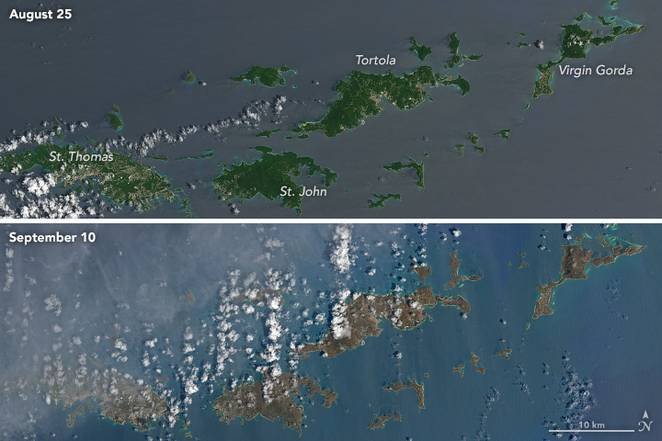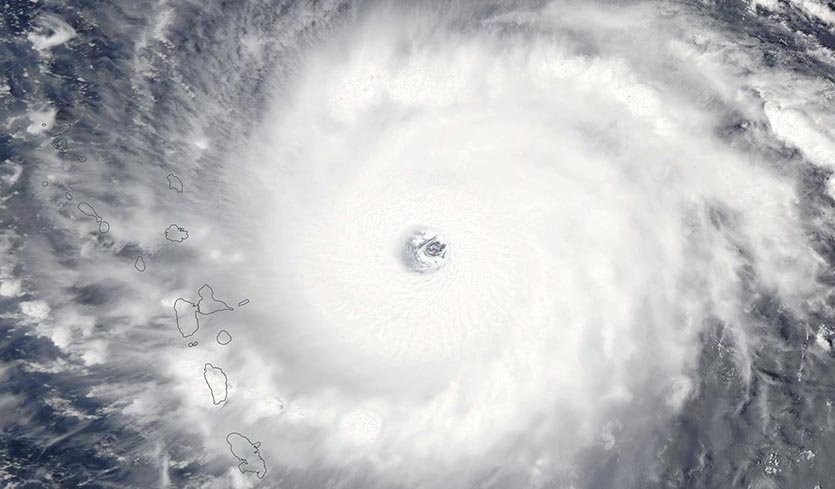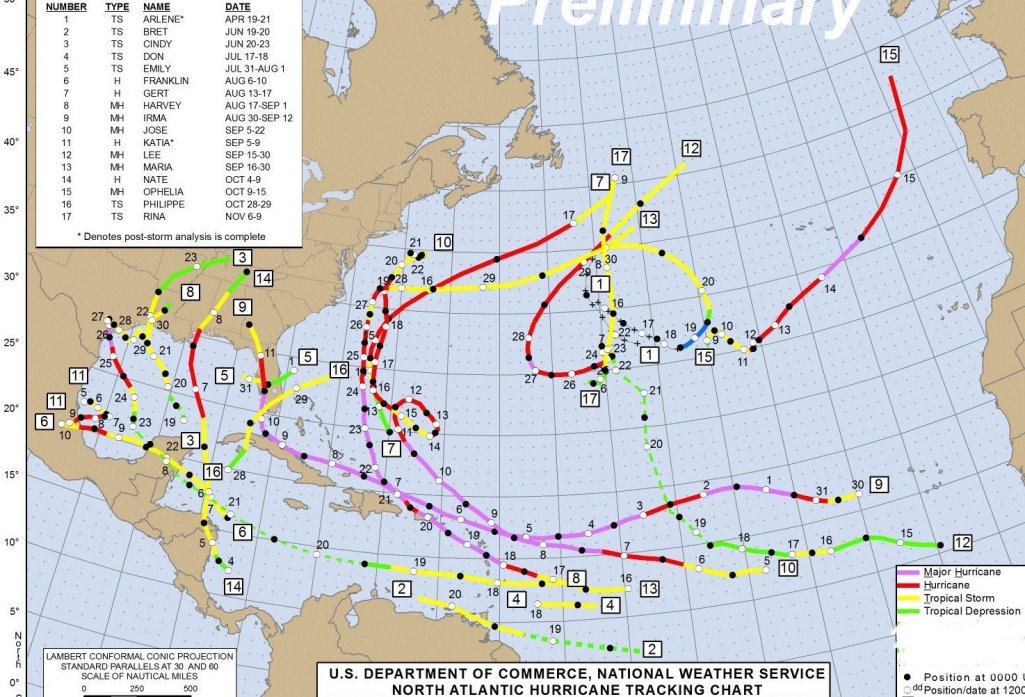2017: Most damaging Atlantic hurricane season of
all
Hundreds
of people died; final death toll may surpass 1000
|
This year has been the most active year for Atlantic hurricanes
since Hurricane Katrina flattened and flooded Louisiana
in 2005. In the Atlantic Ocean, the US National Hurricane
Center tracked 17 named storms (ten hurricanes and
seven tropical storms) in 2017. The Center's Hurricane Tracking
Chart (at the bottom of this page)
shows an active Gulf of Mexico and western Atlantic, just
offshore of the eastern US and Canada. Six of the ten hurricanes
became “major” storms in categories 3, 4, or 5, in which
the peak wind speeds exceeded 111, 130, or 157 miles per
hour, respectively.
Winds greater than 110 miles
per hour will wreak significant damage to homes, trees,
businesses, and power lines. The table
below at right, from the National Hurricane Center,
describes likely damage to homes from hurricane winds in
categories 3, 4, or 5.
The three major hurricanes that
entered the United States this year led to the deaths of
at least 234 persons, and destroyed billions of dollars
worth of property. Hurricane Harvey entered Texas as a category
4 storm, but as its winds diminished, it unleashed torrential
rains totaling 40 to 61 inches (one to 1 ½ meters
of water depth) over several days4. Greater Houston
was effectively washed out. In September, category-5 Hurricane
Irma demolished ten Caribbean island nations or territories,
then marched up the entire length of the state of Florida
as a category 4. Hurricane Maria (also category 5) devastated
first the Virgin Islands, then all of Puerto Rico. More
than 95% of the 3.4 million American citizens of Puerto
Rico lost electricity and piped water for months. Four weeks
after Maria blew through, 80% of the population was still
getting by without electric power, according to the New
York Times.
|

|
| The Virgin
Islands have a thick green forest cover before Hurricane
Irma arrived (top, August 25) but appear brown
and denuded after Irma departed (bottom, September10),
in these images from NASA's Landsat satellite. Credit:
NASA |
|

|
| Hurricane
Irma at maximum intensity (category 5) on Sep. 5. Irma
is about to directly strike the Caribbean islands of
Antigua and Barbuda, then St. Kitts and Nevis, which
are outlined to the left of the eye of the hurricane
in this weather satellite image. |
|
The impact
on human life
These three hurricanes killed
a lot of people in several countries and territories: at
least 84 persons in Harvey, and 95 in Irma. After Hurricane
Maria, the official death count by Puerto Rican authorities
stood at 55 at the end of November, though officials readily
admit this is an undercount. Maria, though, is said to have
indirectly led to over 1000 deaths from the lack of electricity
and running water over months. Two social scientists, Alexis
Santos, at Pennsylvania State University, and Jeffrey Howard,
a health scientist, estimate Maria's indirect
death toll to be 1,085 and rising in Puerto
Rico alone (according to vox.com3).
Santos and Howard culled the Vital Statistics records of
Puerto Rico to compare the number of deaths in September
and October of this year to the historical average of deaths
in September and October over the previous seven years.
And for this year, they counted only the deaths reported
by the Puerto Rico Department of Public Safety. There is
an excess of more than one thousand deaths in those two
months of this year.
|
The cost in
damages
Maria, Harvey, and Irma were
responsible for the most devastation the United States has
ever experienced in one year from hurricanes since, arguably,
the great Galveston hurricane of 1900: damages in the USA
alone amount to the highest on record: $207 billion
(with a “b”). 2 Damages
from Katrina twelve years ago amounted to $100 billion that
the federal government spent, plus $60 billion that private
and federal insurance programs spent–for a sum at least
$160 billion. That figure is less than we are paying for
damages from three hurricanes in 2017.
SOURCES AND CITATIONS:
- "Extremely
active 2017 Atlantic hurricane season finally ends"
(NOAA news, 30 Nov 2017).
- Weather Underground, "2017
U.S. Hurricane Damage Estimate of $206.6 Billion: Highest
on Record", November 28, 2017.
- "New
data shows hurricane deaths in Puerto Rico could be 20
times higher than the government claims by Eliza Barclay
and Alexia Fernández Campbell, Vox.com.
- “Historic
Hurricane Harvey's Recap”, the Weather Channel,
Sep. 4, 2017.
- “Detailed
Meteorological Summary on Hurricane Irma”, NOAA, National
Weather Service, 2017.
|
TABLE:
Saffir-Simpson scale of hurricane intensity, peak winds,
and probable damages
| Hurricane Category |
Highest sustained wind
speed, miles/hr. |
Examples of damages
to homes |
| 1
| 74—95
| SOME damage
|
| 2
| 96—110
| EXTENSIVE damage
|
| 3
| 111—129
| DEVASTATING
damage: There is a very high risk of injury or
death to people, livestock, and pets due to flying
and falling debris. Nearly all older mobile homes
will be destroyed. Unprotected windows will be broken
by flying debris. Well-built frame homes can experience
major damage.
|
| 4
| 130—156
| EXTREME damage:
There is a very high risk of injury or death to
people due to flying and falling debris. Nearly all
older mobile homes will be destroyed. A high percentage
of newer mobile homes also will be destroyed. Poorly
constructed homes can sustain complete collapse of
all walls as well as the loss of the roof structure.
|
| 5
| >157
| CATASTROPHIC
damage: People are at very high risk of injury
or death from flying or falling debris, even if indoors
in mobile homes or framed homes. Almost complete destruction
of all mobile homes will occur, regardless of age
or construction. A high percentage of frame homes
will be destroyed, with total roof failure and wall
collapse.
|
RETURN to Home Page |

Hurricane Tracking Chart shows locations,
tracks, and intensities of Atlantic hurricanes, tropical storms,
and depressions in 2017. Tracks
of "major" hurricanes (MH) are purple; other hurricanes
(H), red; tropical storms (TS), yellow. Numbers in square
boxes at beginning and end of each track reference the hurricane
number in the table at upper left. CREDIT: NOAA, National
Hurricane Center |
|

